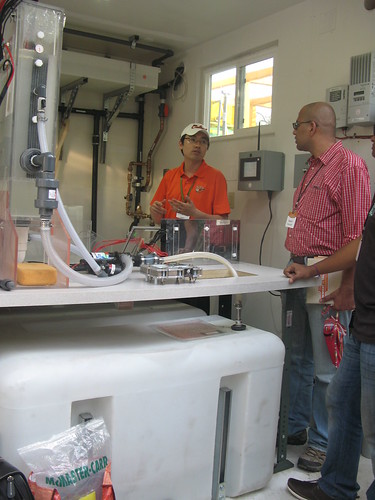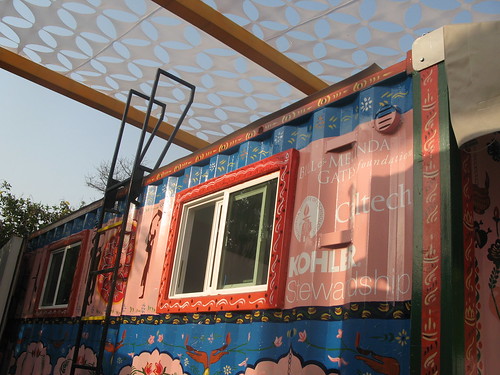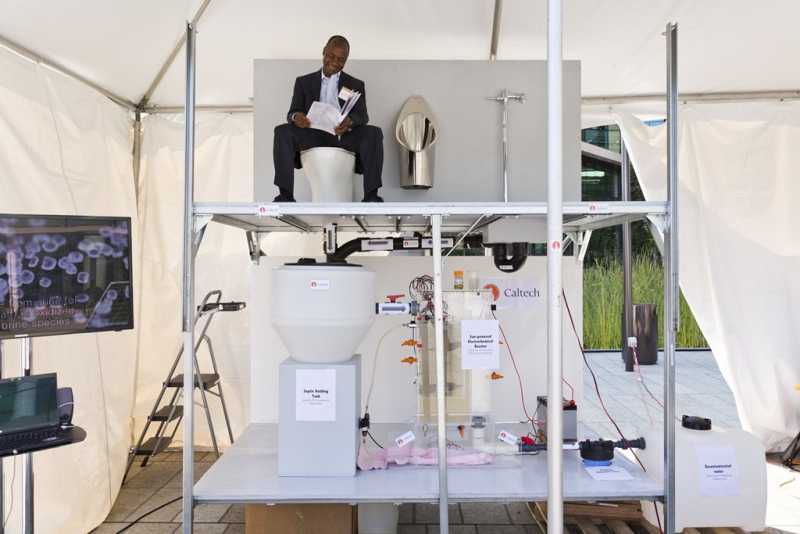- Forum
- categories
- Sanitation systems
- Shared toilets, community toilets, public toilets
- Public toilets in India
- Development of a self-contained, PV-powered domestic toilet and wastewater treatment system (California Institute of Technology, USA)
Development of a self-contained, PV-powered domestic toilet and wastewater treatment system (California Institute of Technology, USA)
15.1k views
- Elisabeth
-
- User is blocked
- Freelance consultant since 2012
Less- Posts: 3372
- Karma: 54
- Likes received: 932
Re: Development of a self-contained, PV-powered domestic toilet and wastewater treatment system (California Institute of Technology, USA)
Development and field-testing of an onsite, self-contained and sun-powered human and toilet wastewater treatment system: Michael Hoffmann, Linde-Robinson Laboratories, California Institute of Technology, Pasadena, Cal, USA
www.susana.org/images/documents/07-cap-d.../3-3-4-1Hoffmann.pdf
The presentation contains a lot of slides with photos, so it will be good to have the video of the presentation available as well (soon I hope - waiting for Tjibbe to send the files to the SuSanA secretariat).
Here one slide from the presentation to wet your appetite to view the presentation:
From my scribbled notes:
- The projet start in mid 2011
- Solar power is stored in batteries
- There is now a collaboration with the company Kohler - to commercialise this
- Test ongoing at an elementary school in China (see photos)
- Membrane bioreactor (MBR) to process collected waste (folded plate anaerobic digester)
- Electrochemical system, oxidise the effluent with chloride - electrode reactor, semi-conductor electrodes
- 100 students use the toilet, only about 10 use it for defecation on a typical day, i.e. contribution of faeces is quite low
- One prototype in Kerala (India) at a university
- No discharge of water
- Anal washing spray provided
- Grinding of solids in the wastewater
- Replacement of batteries needed from time to time
- Aiming for 15,000 USD per complete unit, or around 5,000 USD for a simpler version
- Hydroxy appatite and calcium accumulates but no struvite precipitation
For example, it will also be tested in South Africa as far as I know, see this thread:
forum.susana.org/forum/categories/139-gr...st-partnership#10930
And as far as I know further prototypes (up to 100 if I remember correctly? Will need to check this) will be tested in India.
I don't think this will be a solution for the urban poor, but perhaps for the urban middle-class or specialised applications, such as schools and maybe high-rise buildings with little space and not connected to the sewer. Will be interesting to see how it all pans out.
Regards,
Elisabeth
Freelance consultant on environmental and climate projects
Attachments:
-
 Caltechphoto.jpg
(Filesize: 38KB)
Caltechphoto.jpg
(Filesize: 38KB)
Please Log in to join the conversation.
You need to login to reply- Elisabeth
-
- User is blocked
- Freelance consultant since 2012
Less- Posts: 3372
- Karma: 54
- Likes received: 932
Re: Development of a self-contained, PV-powered domestic toilet and wastewater treatment system (California Institute of Technology, USA)



This last picture might be an "old hat" for professionals working with solar power. But for me it was a new thing: it replaces the former fancy solar panels with a black "solar tar sheet" (what is the exact technical term for it?). It looks very simply but is probably very complex inside. Seems like a wonderful simplication though and less prone to theft and vandalism?
You also see it at minute 6:57 in this video:
Regards,
Elisabeth
Freelance consultant on environmental and climate projects
Please Log in to join the conversation.
You need to login to replyRe: Development of a self-contained, PV-powered domestic toilet and wastewater treatment system (California Institute of Technology, USA)
Thank you for your introduction and your post and congratulations to your work.
I was watching the video were you described the systems in detail.
Could you give more information regarding how far the goals of the RTTC grants will be reached by then (www.susana.org/docs_ccbk/susana_download...y-2013-version-2.pdf):
Create a toilet that:
- removes pathogens from human waste and recovers valuable resources such as energy, clean water, and nutrients.
- operates “off the grid” without connections to water, sewer, or electrical lines.
- costs less than 5 cents per user per day: the anticipated capital and operational cost for the final products (commercial units) is expected to be less than $0.05/user/day, both for the family and neighborhood solutions1.
I would be particularly interested to know what happens with the residues. You mention that so far you did not observe any accumulation of solids in the anaerobic reactor. But in a long-term running system you may will have. What is your approach for the solid part regarding “recovers valuable resources such as energy/nutrients”?
Kind regards
Dorothee
Developing methods and tools to support strategic planning for sustainable sanitation. Particular interested in novel technologies contributing to more inclusive and circular sanitation. This email address is being protected from spambots. You need JavaScript enabled to view it.
Please Log in to join the conversation.
You need to login to reply- Ccid
-
 Less
Less- Posts: 1
- Karma: 1
- Likes received: 0
Re: Development of a self-contained, PV-powered domestic toilet and wastewater treatment system (California Institute of Technology, USA)
I am a PhD. Student in Prof. Michael Hoffmann's group at Caltech and I was with our team at the Reinvent The Toilet Fair India. We presented an integrated version of our toilet wastewater treatment system hosted in a shipping container.
Interview about the project and the prototype:
Tour of the prototype:
Please Log in to join the conversation.
You need to login to reply- Elisabeth
-
- User is blocked
- Freelance consultant since 2012
Less- Posts: 3372
- Karma: 54
- Likes received: 932
Re: Development of a self-contained, PV-powered domestic toilet and wastewater treatment system (California Institute of Technology, USA)
I alerted Michael Hoffmann (the PI (principal investigator) for this grant) to your questions and comments, and he sent me the following e-mail in response:
++++++++++++
Hi Elisabeth:
There are many more interlinked components in the Phase 2 prototypes that will be shipped to India for display at the RTTC Toilet Fair II in March 2014. I have attached a pdf of a PPT presentation outlining many of the modifications incorporated into Phase 2 as compared to the initial demonstration prototype displayed last year. This includes a residual solids handling component that includes rigorous disinfection required to kill helminth eggs. The final product can be used as fertilizer. Keep in mind that we are just in our second year of development, which also includes basic laboratory research on process chemistry, biology, fluid mechanics, physics, battery development, microfluidics, etc.
Mike
Prof. Dr. Michael R. Hoffmann
Member of the National Academy of Engineering
James Irvine Professor
204 Linde-Robinson Laboratories
California Institute of Technology
Pasadena, CA 91125-0001 USA
Web: www.hoffmann.caltech.edu
Please log in or register to see it.
+++++++++++++++
I looked at the presentation, very interesting, nice photos. It would be good to have the text that went with the presentation to understand it better.
Overall, I would say there is no way that this could ever meet the famous 5 Cent requirement (see our other discussion here: forum.susana.org/forum/categories/139-ge...mit=12&start=24#5549). But I guess that is not the aim here.
Regards,
Elisabeth
Freelance consultant on environmental and climate projects
This message has an attachment file.
Please log in or register to see it.
Please Log in to join the conversation.
You need to login to replyRe: Development of a self-contained, PV-powered domestic toilet and wastewater treatment system (California Institute of Technology, USA)
I think this project was already discussed earlier here, as it was the winner of the first round. Somehow I did not manage to find these posts again(I assume all old posts should be still available?).
(reply by moderator EvM to Florian: yes, you are right. I found them and moved them into this thread now, please scrol up)
I remember that I (or others) found two particular critical points to this project:
- The main element of the technology is a simple septic tank, all the tech proposed is to treat the liquid phase only, while not bothering at all about sludge management. So not really "self contained".
- The process to treat the liquid phase is probably quite energy consuming. I don't find the proposal of putting a PV panel for this a very convincing solution, it doesn't change the fact of high energy consumption.
Some time has passed since the first round, so I'd be curious to hear how these points have been addressed meanwhile.
Best, Florian
Please Log in to join the conversation.
You need to login to reply- Elisabeth
-
- User is blocked
- Freelance consultant since 2012
Less- Posts: 3372
- Karma: 54
- Likes received: 932
Re: Development of a self-contained, PV-powered domestic toilet and wastewater treatment system (California Institute of Technology, USA)
I saw this photo of Doulaye Koné (Gates Foundation) today on their blog:
See here:
www.impatientoptimists.org/Posts/2013/08...-the-toilet-in-China
This was interesting to me:
So, we brought together some of China’s leading excrement experts to launch China’s own Reinvent the Toilet Challenge.
The foundation has partnered with the University of Science and Technology Beijing (USTB) to call for proposals from China’s leading research institutions, non-profits and companies. The funding amount will depend on the proposal, but budgets are expected to fall somewhere between $100k and $500k.
In addition to noodles, kites, and fireworks, historians credit China with the invention of toilet paper. Here’s to hoping it can reinvent the toilet to go with it.
Freelance consultant on environmental and climate projects
Attachments:
-
 doulayekon...pped.jpg
(Filesize: 38KB)
doulayekon...pped.jpg
(Filesize: 38KB)
Please Log in to join the conversation.
You need to login to reply- Elisabeth
-
- User is blocked
- Freelance consultant since 2012
Less- Posts: 3372
- Karma: 54
- Likes received: 932
Re: Development of a self-contained, PV-powered domestic toilet and wastewater treatment system (California Institute of Technology, USA)
Who is Michael Hoffmann?
See some basic details here:
Prof. Dr. Michael R. Hoffmann
Member of the National Academy of Engineering
James Irvine Professor of Environmental Science & Engineering
204 Linde-Robinson Laboratories
California Institute of Technology
Pasadena, CA 91125-0001 USA
Web: www.hoffmann.caltech.edu
Title of grant:
Development of a Self-Contained, PV-Powered Domestic Toilet and Wastewater Treatment System
- Subtitle: Solar-powered electrochemical wastewater treatment system with recycle of the treated water back into the toilet flushing system.
- Name of lead organization: California Institute of Technology
- Primary contact at lead organization: Prof. Dr. Michael Hoffmann
- Grantee location: Pasadena, CA, USA
- Developing country where the research is being or will be tested: India
The researchers (sitting on the prototype, in mid 2012):
The prototype system:
Short description of the project:
The goal of this project is to design a self-contained, solar-powered domestic toilet and wastewater treatment system. The solar panel will convert the sun’s rays into enough energy to power an electrochemical reactor that Hoffmann designed to break down water and human waste into hydrogen gas. The gas can then be stored in hydrogen fuel cells to provide a backup energy source for nighttime operation or for use under low-sunlight conditions.
Goal(s):
To design, build, and test a self-contained, solar-powered domestic toilet and wastewater treatment system.
Objectives:
On a pilot-plant scale with have developed a transportable prototype design for the treatment of raw domestic wastewater, human urine, human feces, and synthetic human waste analogues. After several hours of PV-powered electrochemical treatment, the turbid, black-water influent can be clarified with the elimination of the suspended particles along with the reduction or total elimination of the chemical oxygen demand (COD), total enteric coliform disinfection via in situ reactive chlorine species generation, and the elimination of measurable protein after 3 to 4 hours of PV-powered treatment. Our Phase II prototype incorporates additional features such as a residual sludge handling unit, a hydrogen purification and filter system, a closed water reuse We have packaged our second-generation prototypes into modified shipping containers are ready for field testing in remote locations that lack traditional urban infrastructure. Alternative applications include electrochemically-enhanced septic tanks.
We have developed an infrastructure-free, self-contained wastewater treatment system that incorporates a series of PV-powered electrolysis cells that generate molecular hydrogen for subsequent conversion to electricity in a hydrogen fuel cell. First, we will report on the efficacy of a laboratory-scale using real human waste containing feces and urine using bismuth oxide doped titanium dioxide (BiOx/TiO2) electrode arrays.
A comprehensive environmental analysis has been coupled together with a robust kinetic model based under the chemical reaction limited regime to investigate the role of various redox reactions mediated by chloride present in human waste. Under current densities (J) higher than 200 A m–2, the oxidative elimination of the chemical oxygen demand (COD) and ammonium ion can be modeled using experimentally-determined pseudo first-order rate constants and current efficiencies In combination with an anaerobic pretreatment step, the real human wastes including COD, protein and color are eliminated within 6 hours of continuous treatment in the electrochemical reactor array.
Grant type: RTTC Round 1 (Reinvent the Toilet Challenge)
Grant size according to BMGF website: June 2011: USD 500,000 and Oct. 2012: USD 1,194,684 and another $ 1,657,655 for the funding phase 2016-2018 (source: www.gatesfoundation.org/How-We-Work/Quick-Links/Grants-Database)
Start and end date: July 2011 to January 2014 (edit: extended to May 2018)
Funding for this research currently ongoing (yes/no): yes
Research or implementation partners: BMGF, Kohler, Roca, Falcon Water Free
Links, further readings:
Documents in SuSanA library: www.susana.org/en/resources/library/details/1831
Video of the presentation of Clément Cid (PhD student on the project) from FSM2 Conference:
A promotional video from July 2012 which explains the prototype of the toilet (built for the toilet fair in Seattle in August 2012) - the video attracted 45,600 views and 45 comments; this prototype toilet won first prize at that toilet fair:
Short video about winning the first prize:
Short video about the toilet fair in general in Seattle in August 2012:
Youtube channel of Michael Hoffmann: www.youtube.com/SOLARH2
Press release from 2011:
hoffmann.caltech.edu/2011/07/19/caltech-...d-sanitation-system/
Further concept ideas (sketches):
Please log in or register to see it.
Other papers covering the topic: see www.hoffmann.caltech.edu
One example paper out of a long list of papers:
Title: Electrochemical oxidation and microfiltration of municipal wastewater with simultaneous hydrogen production: Influence of organic and particulate matter
Author(s): Park, H (Park, Hana); Choo, KH (Choo, Kwang-Ho); Park, HS (Park, Hak-Soon); Choi, J (Choi, Jina); Hoffmann, MR (Hoffmann, Michael R.)
Source: CHEMICAL ENGINEERING JOURNAL Volume: 215 Pages: 802-810
DOI: 10.1016/j.cej.2012.11.075 Published: JAN 15 2013
Abstract:
Electrochemical reactions, which can produce molecular hydrogen via water splitting, can degrade organic contaminants in water simultaneously. This study focused on the production of hydrogen gas during the electrochemical treatment of organic matter and colloids present in actual municipal wastewater. The electrochemical system used in this study consisted of a BiOx-TiO2/Ti anode and two stainless steel cathodes. Hydrogen generation was enhanced in the presence of wastewater organic matter and/or supplemental NaCl. During the electrochemical reaction, the chemical oxygen demand, proteins, and turbidity were removed well, whereas the dissolved organic carbon, carbohydrates, and organic acids concentrations remained unchanged or rather increased. The increase in dissolved carbon content was ascribed to the conversion of particulate colloids to soluble fractions and thereafter incomplete mineralization. Both the loss of organic fluorophores and the formation of large molecular organics during electrochemical oxidation exhibited the degradation of primarily present organics as well as the solubilization of particulate colloids. The accumulation and formation of oxalate and chlorinated intermediates, such as trichloromethane, also occurred. The wastewater particles larger than 0.1 mu m in size were responsible for the formation of dissolved organic intermediates, but such colloidal particles seemed beneficial to hydrogen generation. Microfiltration in conjunction with electrochemical treatment showed the potential to produce good quality effluent at a high permeability while simultaneously generating hydrogen energy. (C) 2012 Elsevier B.V. All rights reserved.
Current state of affairs:
We have built a TRL 7 (*) working prototype that has been tested with actual human waste generated in the facility by 35 users. We are building several more working prototypes for shipping abroad for testing in India and for display at the Reinvent the Toilet Fair 2 in New Delhi in March 2014.
Biggest successes so far:
We have been able to successfully treat actual human wastes (e.g., feces, urine, and flush water) such that the effluent from the treatment scheme can be recycled into flushing water.
Main challenges / frustration:
Being able to integrate the details of construction along with the required testing of water quality as a function of time. In addition, we are trying to ensure that the PhD students working on the project can do fundamental research at the forefront of science that will satisfy the demands of our faculty.
Costs of such a system? Answer by Michael Hoffmann: "We hope that a system using much more simple components for construction will cost out USD 1000 per unit." (note by EvM: I assume this means for one family)
(*) TRL stands for Technology Readiness Level, and is measure on a scale of 1 to 9. Where 1 is: Basic principles observed and reported, 7 is: System prototype demonstration in an operational environment and 9 is: Actual system proven through successful mission operations. See also here for more details (not specific to sanitation): en.wikipedia.org/wiki/Technology_readiness_level
Freelance consultant on environmental and climate projects
Attachments:
-
 picture1.png
(Filesize: 188KB)
picture1.png
(Filesize: 188KB)
-
 projectteam.jpg
(Filesize: 49KB)
projectteam.jpg
(Filesize: 49KB)
Please Log in to join the conversation.
You need to login to replyRe: Gates Foundation launches 2nd round of reinvent the toilet challenge
So this is really the best that came out of that competition?
Please Log in to join the conversation.
You need to login to replyRe: Gates Foundation launches 2nd round of reinvent the toilet challenge
But maybe the final product (if it ever materializes) will be something really nice...
Please Log in to join the conversation.
You need to login to replyGates Foundation launches 2nd round of reinvent the toilet challenge
"They would repurpose the solar panels and batteries to powering TVs and charging cell phones and go back to shovels for their sanitary needs.", says one YouTube user.
Such a comment (as true as it is) only tells me that the "let's do this for developing countries 1!11"-approach is too limited. I'd love to see a system that has been designed for developed countries.
I understand it's just a prototype at the moment and that the future toilet probably will be a healthy mixture of all systems (hence also why there's round 2), but going by this video alone, it would have been great to see real life tests with fresh faeces, tissues, napkins, condoms, hair and what else it usually flushed down a toilet. They've used primary sludge instead which often doesn't contain the bigger parts, but which would quickly kill any such system. Going by this video alone, the winner is just an alternative to conventional biochemical waste water treatment - which would even work with sewage systems.
watsan eng.
water, sanitation, IT & knowledge management
www.saniblog.org
Toilets in Frankfurt/Main www.facebook.com/ffmtoi
Please Log in to join the conversation.
You need to login to reply- Forum
- categories
- Sanitation systems
- Shared toilets, community toilets, public toilets
- Public toilets in India
- Development of a self-contained, PV-powered domestic toilet and wastewater treatment system (California Institute of Technology, USA)








